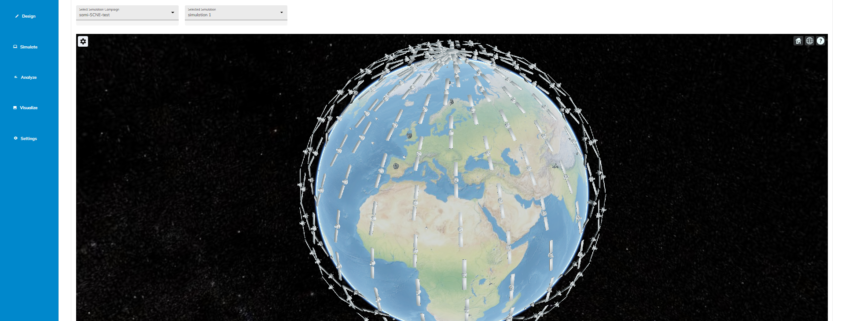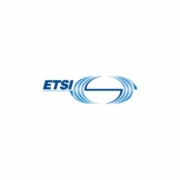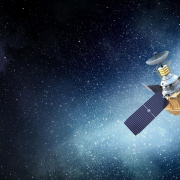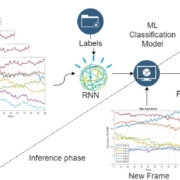NGSO communications constellations are here: covering the globe for high throughput
Trending now: Non-Geosynchronous Orbit (NGSO) communications constellations. Runners like Starlink now consider manufacturing tens of thousands of satellites to form their own constellations. Magister’s new simulator makes it possible to study and assess the performances of these new mega constellations.
In 2021, more than 3 000 active satellites orbit the Earth. Traditionally, satellite communication has involved geosynchronous orbit (GEO), but now the NGSO constellations are gaining momentum.
NGSO constellations include both Low-Earth-Orbit (LEO) and Medium-Earth-Orbit (MEO) satellites. For global coverage, these constellations require countless satellites and are somewhat more complex systems to operate and optimize. If current LEO satellite proposals become a reality, about 50 000 active satellites shall orbit the earth within the next ten years.
We at Magister, Airbus Defence and Space (ADS) in France and the VTT Technical Research Centre of Finland are searching for technological options to optimize LEO mega constellations. The objective of our SCNE project is to enable the study and assessment of protocol performances of these new constellations, especially focusing on routing protocols – which may affect the end to end quality of service – in particular.
A system simulator makes studying routing in space easier
There are several technological challenges with regards to designing LEO satellite constellation networks. Being able to manage the cost of the constellations and at the same time assess the offered quality of service is critical to the satellite operator when they want to secure their business case.
One of the challenges of large LEO mega constellations with global coverage is the number and availability of GW locations. Either a huge number of GWs are needed all over the world or the satellites need to be equipped with Inter-Satellite Links (ISLs) and routing capabilities. Satellites linked together form a network in space enabling shorter delays and a fully global coverage.
SCNE project is developing a system simulator for LEO satellite constellation protocol and performance optimization.
– We are examining how mega constellations could utilize ISLs in the most efficient way and perform routing in space. ISL routing algorithms are likely to be the future of the satellite constellations. Some operators like TeleSat are already headed towards this development, says Magister’s Director of Simulation Services, Jani Puttonen.
A decoupled architecture, which uses AGI’s Systems Tool Kit (STK) and a ns-3 open source network simulator, has been adopted in the project. This approach makes it possible to benefit from the capabilities of STK related to the orbital propagation, antenna modelling, link budget calculations and ns-3 with regards to protocol and network level modeling.
– STK simulates the movement of the satellites and the way they communicate with each other. This enables our network simulator to focus on communication protocol modeling and routing algorithms.
The time is right for LEO satellite constellations
It might come as a surprise, but NGSO satellite constellation is not a new invention. Similar attempts were made in the 90’s, but most of them failed due to financial, technical and other difficulties.
Now the idea of using constellations in the building of future SatCom systems has created increased momentum. There are several reasons why this second attempt is more likely to be successful:
- The demand for bandwidth and low latency communications is constantly increasing, also in the rural, hard/impossible-to-reach areas (such as seas, mountains and deserts).
- Technology has taken some major leaps, e.g. in terms of frequency resources and usage, antenna technologies, satellite launch technologies, satellite mass production, etc. Making these technologies first of all available, but also cheaper.
- More capital is now available e.g. through investors. SatCom is a CAPEX intensive business.
- So called NewSpace players have entered the field with new innovative mindsets.
- New business cases: E.g. digital divide, but also seamless connectivity directly to handheld and Internet-of-Things.
- 3GPP 5G Non-Terrestrial Network (NTN) standardization as a global standard for connectivity. Standardization work brings new vendors, increasing competition and cheaper production.
So in many ways, the future is already here, and things are moving forward quickly. We have included the SCNE simulator in our SimLab service to study for example advanced ISL routing algorithms, mobility management, and related higher layer & end-to-end performance.
If you want to know more, read more about our SimLab service and just be in touch!
Summary:
- Magister, Airbus Defence and Space (ADS) (France) and the VTT Technical Research Centre of Finland are searching for technological options for the LEO mega constellations.
- The SCNE project aims to study and assess protocol performances of these mega constellations, in particular routing protocols which may affect the end to end quality of service.
- SCNE network simulator is included in our SimLab service for researching e.g. advanced ISL routing algorithms, mobility management, and related higher layer & end-to-end performance.
Keywords: NGSO, LEO, MEO, GEO, SCNE, 5G, 3GPP, SimLab











